JVC GR-DV2000 User Manual
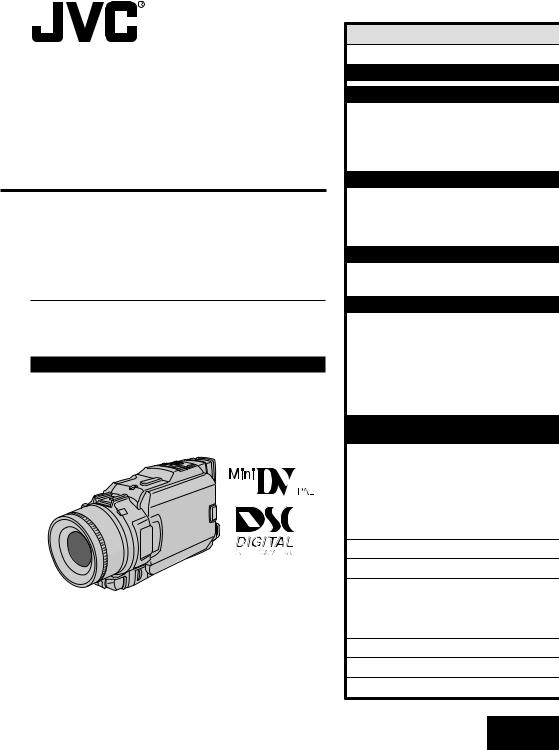
DIGITAL VIDEO CAMERA
GR-DV2000
Please visit our Homepage on the World Wide Web and answer our Consumer Survey
(in English only):
http://www.jvc-victor.co.jp/english/index-e.html
INSTRUCTIONS
|
ENGLISH |
|
CONTENTS |
|
|
AUTOMATIC DEMONSTRATION |
5 |
|
GETTING STARTED |
6 – 15 |
|
RECORDING |
16 – 37 |
|
Basic Recording For Video ........................ |
|
16 |
Basic Recording For Digital Still Camera |
|
|
(D.S.C.) ............................................ |
|
19 |
Basic Recording For Video And D.S.C. |
.......... |
20 |
Advanced Features For Video And D.S.C. ...... |
22 |
|
PLAYBACK |
38 – 51 |
|
Basic Playback For Video ......................... |
|
38 |
Advanced Features For Video ................... |
|
39 |
Basic Playback For D.S.C. ........................ |
|
42 |
Advanced Features For D.S.C. ................... |
|
44 |
CONNECTIONS |
52 – 55 |
|
Basic Connections .................................. |
|
52 |
Advanced Connections ............................ |
|
54 |
DUBBING |
56 – 60 |
|
Dubbing To A VCR ................................. |
|
56 |
Dubbing From A VCR .............................. |
|
57 |
Dubbing To A Video Unit |
|
|
Equipped With A DV Connector ................ |
|
58 |
Dubbing From A Video Unit |
|
|
Equipped With A DV Connector ................ |
|
59 |
Dubbing Images Recorded |
|
|
On A Tape To A Memory Card ................. |
|
60 |
USING THE REMOTE |
|
|
CONTROL UNIT |
61 – 72 |
|
Slow-Motion Playback, Frame-By-Frame |
|
|
Playback and Playback Zoom .................. |
|
63 |
Playback Special Effects .......................... |
|
64 |
Random Assemble Editing ........................ |
|
65 |
For More Accurate Editing ........................ |
|
69 |
Audio Dubbing ...................................... |
|
71 |
Insert Editing ....................................... |
|
72 |
TROUBLESHOOTING |
73 – 79 |
|
USER MAINTENANCE |
|
80 |
INDEX |
81 – 88 |
|
Jack Box ............................................ |
|
81 |
Controls, Connectors And Indicators ............ |
|
82 |
Indications .......................................... |
|
84 |
CAUTIONS |
89 – 91 |
|
TERMS |
92 – 93 |
|
SPECIFICATIONS |
94 – 95 |
|
LYT0755-001A EN
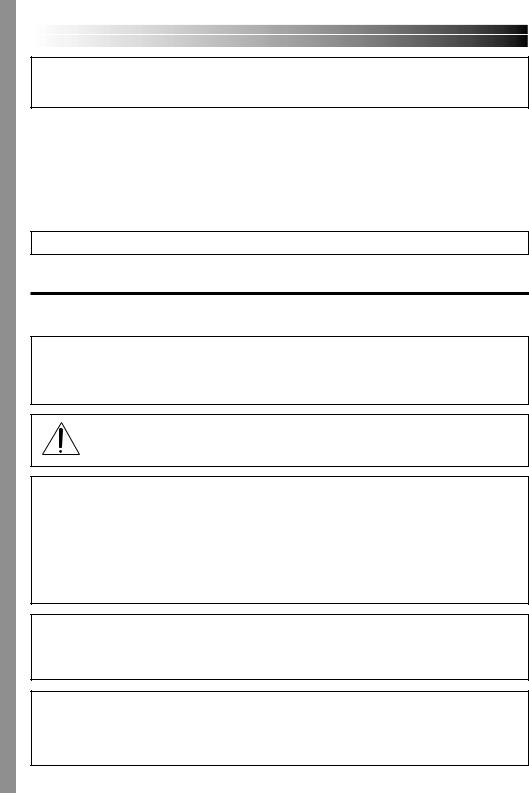
2 EN
Dear Customer,
Thank you for purchasing this digital video camera. Before use, please read the safety information and precautions contained in the following pages to ensure safe use of this product.
Using This Instruction Manual
•All major sections and subsections are listed in the Table Of Contents on the cover page. •Notes appear after most subsections. Be sure to read these as well.
•Basic and advanced features/operation are separated for easier reference.
It is recommended that you . . .
.... refer to the Index ( pgs. 81 – 88) and familiarize yourself with button locations, etc. before use.
.... read thoroughly the Safety Precautions. They contain extremely important information regarding the safe use of this product.
You are recommended to carefully read the cautions on pages 89 through 91 before use.
SAFETY PRECAUTIONS
WARNING:
TO PREVENT FIRE OR SHOCK HAZARD, DO NOT EXPOSE THIS UNIT TO RAIN OR MOISTURE.
Caution: (applies to Jack Box)
To reduce the risk of fire, do not remove cover. No user-serviceable parts inside. Refer servicing to qualified service person.
CAUTIONS:
If you notice smoke or a peculiar smell coming from the camcorder or AC adapter/charger, shut it down and unplug it immediately. Continue using the camcorder or AC adapter/charger under these conditions could lead to fire or electric shock. Contact your JVC dealer. Do not attempt to repair the malfunction yourself.
To prevent shock, do not open the cabinet. No user serviceable parts inside. Refer servicing to qualified personnel.
When you are not using the AC Power Adapter/Charger for a long period of time, it is recommended that you disconnect the power cord from AC outlet.
NOTES:
●The rating plate (serial number plate) and safety caution are on the bottom and/or the back of the main unit.
●The rating plate (serial number plate) of the AC Power Adapter/Charger is on its bottom.
This camcorder is designed to be used with PAL-type colour television signals. It cannot be used for playback with a television of a different standard. However, live recording and LCD monitor/ viewfinder playback are possible anywhere. Use the JVC BN-V408U/V416U/V428U battery packs and, to recharge them, the provided multi-voltage AC Power Adapter/Charger. (An appropriate conversion adapter may be necessary to accommodate different designs of AC outlets in different countries.)
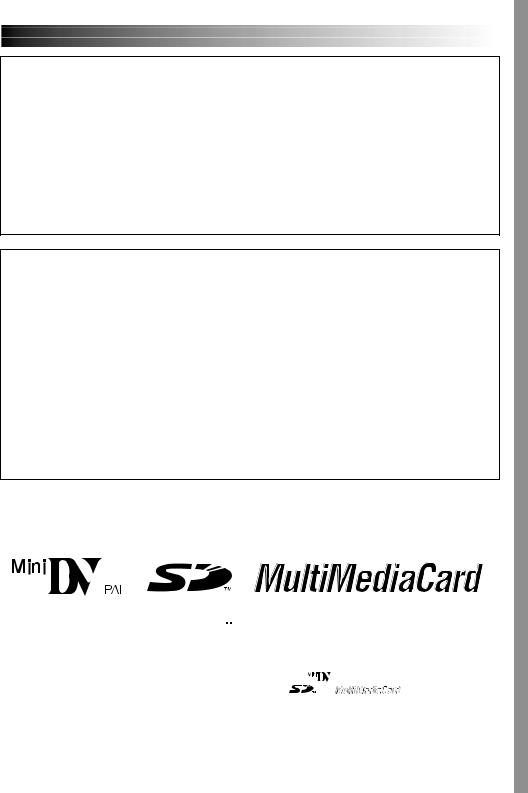
EN3
When the equipment is installed in a cabinet or on a shelf, make sure that it has sufficient space on all sides to allow for ventilation (10 cm or more on both sides, on top and at the rear).
Do not block the ventilation holes.
(If the ventilation holes are blocked by a newspaper, or cloth etc. the heat may not be able to get out.) No naked flame sources, such as lighted candles, should be placed on the apparatus.
When discarding batteries, environmental problems must be considered and the local rules or laws governing the disposal of these batteries must be followed strictly.
The apparatus shall not be exposed to dripping or splashing.
Do not use this equipment in a bathroom or places with water.
Also do not place any containers filled with water or liquids (such as cosmetics or medicines, flower vases, potted plants, cups etc.) on top of this unit.
(If water or liquid is allowed to enter this equipment, fire or electric shock may be caused.)
Do not point the lens or the viewfinder directly into the sun. This can cause eye injuries, as well as lead to the malfunctioning of internal circuitry. There is also a risk of fire or electric shock.
CAUTION!
The following notes concern possible physical damage to the camcorder and to the user.
When carrying, be sure to always securely attach and use the provided shoulder strap. Carrying or holding the camcorder by the viewfinder and/or the LCD monitor can result in dropping the unit, or in a malfunction.
Take care not to get your finger caught in the cassette holder cover. Do not let children operate the camcorder, as they are particularly susceptible to this type of injury.
Do not use a tripod on unsteady or unlevel surfaces. It could tip over, causing serious damage to the camcorder.
CAUTION!
Attaching the Jack Box to the camcorder with cables (S-Video, Editing, DC, etc.) connected, then leaving it on top of the TV is not recommended, as tripping on the cables will cause the camcorder to fall, resulting in damage.
Attach only the optional JVC VL-V3U Video Light, VL-F3U Video Flash or MZ-V3U Stereo Zoom Microphone to the camcorder’s Info-Shoe.
This camcorder is designed exclusively for the digital video cassette, SD Memory Card and MultiMediaCard. Only cassettes marked “

 ” and memory cards marked “
” and memory cards marked “

 ” or
” or
“




 ” can be used with this unit.
” can be used with this unit.
Before recording an important scene . . . |
|
|
.... make sure you only use cassettes with the Mini DV mark |
|
. |
.... make sure you only use memory cards with the mark |
or |
. |
.... remember that this camcorder is not compatible with other digital video formats.
.... remember that this camcorder is intended for private consumer use only. Any commercial use without proper permission is prohibited. (Even if you record an event such as a show, performance or exhibition for personal enjoyment, it is strongly recommended that you obtain permission beforehand.)
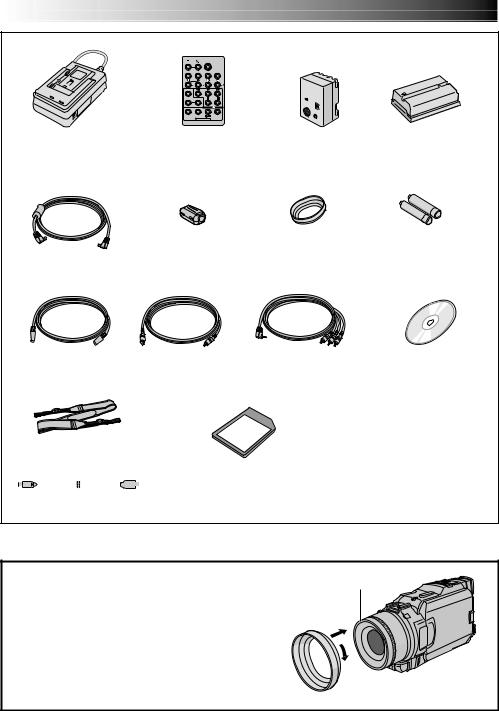
4 EN |
PROVIDED ACCESSORIES |
•AC Power Adapter/Charger AA-V40EA, AA-V40A, AA-V40A-S, AA-V40SH or AA-V40ED
• DC Cord
• S-Video Cable
• Shoulder Strap
• Remote Control Unit |
• Jack Box |
RM-V716U |
CU-V504U |
• Core Filter |
• Lens Hood |
(for an optional |
(See below for |
external microphone) |
attachment) |
• Editing Cable |
• Audio/Video Cable |
|
(ø3.5 mini-plug to |
|
RCA plug) |
|
|
|
|
|
|
|
|
|
|
|
|
• MultiMediaCard |
|
|
|
|
|
|
|
|
|
|
|
|
(GR-DV2000EA/A/A-S: 16 MB, |
|
|
|
|
|
|
|
|
|
|
|
|
|
|
|
|
|
|
|
|
|
|
|
|
|
GR-DV2000SH/ED: 8 MB) |
|
|
|
|
• USB Cable |
|
|
|
|
|
|
|
|
|
|
|
|
|
|
|
|
|
|
|
(Already inserted in the camcorder) |
|
|
|
|
|
|
|
|
|
|
|
|
|
•Battery Pack BN-V408U
•AAA (R03) Battery x 2 (for remote control unit)
•CD-ROM
The CD ROM contains the following 5 software programmes:
•USB Driver Soft (for Windows®)
•USB Driver Soft (for Macintosh®)
Presto!
•Mr. Photo
•PhotoAlbum
•ImageFolio
How To Attach The Lens Hood
The provided lens hood helps block out glare when shooting under bright sunlight, the same way professional photographers do.
Align the lens |
Threading |
|
|
hood with the |
|
camcorder’s lens |
|
and screw it in |
|
clockwise. |
|
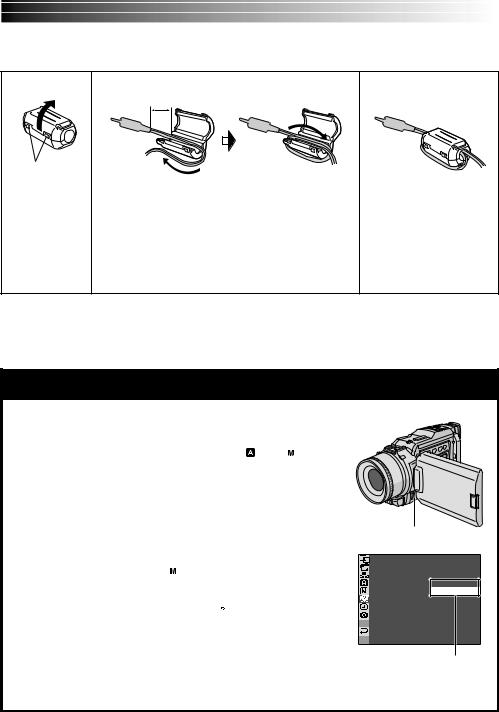
EN5
How To Attach Core Filter
Attach the provided Core Filter to an optional external microphone. Core Filter reduces interference.
1 2
3 cm
Stopper |
|
|
wind once |
|
|
||
|
|
|
|
Release the |
Run the cable through the Core Filter, leaving approx. |
||
stoppers on both |
3 cm of cable between the cable plug and the Core |
||
ends of the Core |
Filter. Wind the cable around the outside of the Core |
||
Filter. |
Filter as shown in the illustration. |
||
|
•Wind the cable so that it is not slack. |
||
|
NOTE: |
||
|
Take care not to damage the cable. |
||
3
Close the Core Filter until it clicks shut.
When connecting cables, attach the end with the Core Filter to the camcorder.
AUTOMATIC DEMONSTRATION
Automatic Demonstration takes place when “DEMO MODE” is set to “ON” (factory-preset).
Available when the Power Switch is set to “ ” or “ ” and no cassette is in the camcorder.
” and no cassette is in the camcorder.
Performing any operation during the demonstration stops the demonstration temporarily. If no operation is performed for more than 1 minute after that, the demonstration will resume.
“DEMO MODE” remains “ON” even if the camcorder power is turned off.
To cancel Automatic Demonstration:
1.Set the Power Switch to “ ” while pressing down the Lock Button located on the switch and press the MENU wheel. The Menu Screen appears.
” while pressing down the Lock Button located on the switch and press the MENU wheel. The Menu Screen appears.
2.Rotate the MENU wheel to select “  SYSTEM” and press it. The SYSTEM Menu appears.
SYSTEM” and press it. The SYSTEM Menu appears.
3.Rotate the MENU wheel to select “DEMO MODE” and press it. The Sub Menu appears.
4.Rotate the MENU wheel to select “OFF” and press it.
5.Rotate the MENU wheel to select “1RETURN”, and press it twice. The normal screen appears.
MENU Wheel
DEMO MODE – OFF
ON
Sub Menu
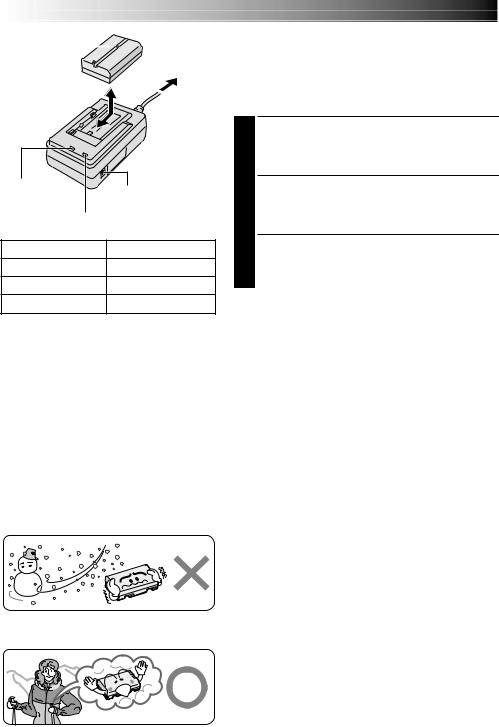
6 EN |
|
GETTING STARTED |
||
|
Battery pack |
|
|
Power |
|
|
|||
|
BN-V408U, |
|
|
This camcorder’s 2-way power supply system lets you |
|
BN-V416U or |
To AC outlet |
choose the most appropriate source of power. Do not use |
|
|
BN-V428U |
|||
|
|
provided power supply units with other equipment. |
||
|
|
|
|
|
|
AC Power |
|
Adapter/ |
|
Charger |
POWER |
DC OUT connector |
indicator |
|
CHARGE indicator |
|
Battery pack |
Fully charging time |
BN-V408U |
approx. 1 hr. 30 min. |
BN-V416U (optional) |
approx. 2 hrs. |
BN-V428U (optional) |
approx. 3 hrs. 20 min. |
NOTES:
CHARGING THE BATTERY PACK
1 Make sure you unplug the camcorder’s DC cord from the AC Power Adapter/Charger. Plug the AC Adapter/ Charger’s power cord into an AC outlet. The POWER indicator lights.
2 Attach the battery pack with the 
 mark aligned with the corresponding marks on the AC Power Adapter/Charger. The CHARGE indicator begins blinking to indicate charging has started.
mark aligned with the corresponding marks on the AC Power Adapter/Charger. The CHARGE indicator begins blinking to indicate charging has started.
3 When the CHARGE indicator stops blinking but stays lit, charging is finished. Slide the battery and lift off. Remember to unplug the AC Adapter/Charger’s power cord from the AC outlet.
●If the protective cap is attached to the battery pack, remove it first.
●Perform charging where the temperature is between 10°C and 35°C. 20°C to 25°C is the ideal temperature range for charging. If the environment is too cold, charging may be incomplete.
●Charging times noted above are for a fully discharged battery pack.
●Charging time varies according to the ambient temperature and the status of the battery pack.
●To avoid interference with reception, do not use the AC Power Adapter/Charger near a radio.
●If you connect the camcorder’s DC cord to the adapter during battery charging, power is supplied to the camcorder and charging stops.
●Since the AC Power Adapter/Charger processes electricity internally, it becomes warm during use. Be sure to use it only in well-ventilated areas.
●When charging the battery pack for the first time or after a long storage period, the CHARGE indicator may not light. In this case, remove the battery pack from the AC Power Adapter/Charger, then try charging again.
●If the battery operation time remains extremely short even after having been fully charged, the battery is worn out and needs to be replaced. Please purchase a new one.
Lithium-ion is vulnerable in colder temperatures.
About Batteries
DANGER! Do not attempt to take the batteries apart, or expose them to flame or excessive heat, as it may cause a fire or explosion.
WARNING! Do not allow the battery or its terminals to come in contact with metals, as this can result in a short circuit and possibly start a fire.
The Benefits Of Lithium-Ion Batteries
Lithium-ion battery packs are small but have a large power capacity. However, when one is exposed to cold temperatures (below 10°C), its usage time becomes shorter and it may cease to function. If this happens, place the battery pack in your pocket or other warm, protected place for a short time, then re-attach it to the camcorder. As long as the battery pack itself is not cold, it should not affect performance.
(If you’re using a heating pad, make sure the battery pack does not come in direct contact with it.)
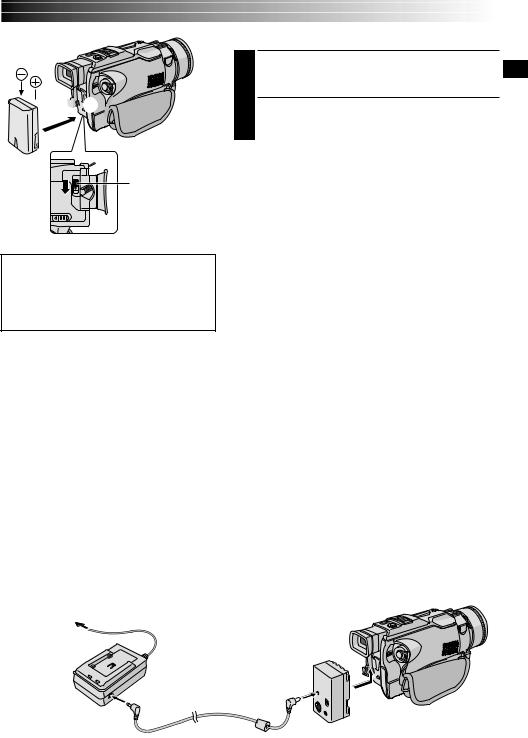

 1
1  2
2 
BATT. RELEASE
Switch
ATTENTION:
Before detaching the power source, make sure that the camcorder’s power is turned off. Failure to do so can result in a camcorder malfunction.
INFORMATION:
The extended-use battery pack kit is a set composed of a battery pack and AC Power Adapter/Charger: VU-V840 KIT : BN-V840U battery pack & AA-V15
AC Power Adapter/Charger VU-V856 KIT : BN-V856U battery pack & AA-V80
AC Power Adapter/Charger Read the kit's instruction manual before using. Neither BN-V840U nor BN-V856U can be charged by using the AC Power Adapter/Charger provided with this camcorder. Use only the
AA-V15 AC Power Adapter/Charger for BN-V840U battery pack and only AA-V80 AC Power Adapter/ Charger for BN-V856U battery pack .
EN7
USING THE BATTERY PACK
1 With the arrow on the battery pack pointing upward, push the battery pack slightly against the battery pack mount 1.
2 Slide up the battery pack until it locks in place 2.
•If the battery pack is attached with its 
 mark set in the wrong direction, a malfunction may occur.
mark set in the wrong direction, a malfunction may occur.
To Detach The Battery Pack . . .
.... slide the battery pack down slightly while sliding down BATT. RELEASE to detach it.
Approximate recording time
Battery pack |
LCD monitor on/ |
LCD monitor off/ |
|
Viewfinder off |
Viewfinder on |
|
|
|
BN-V408U |
1 hr. 5 min. |
1 hr. 15 min. |
|
|
|
BN-V416U |
2 hrs. 10 min. |
2 hrs. 30 min. |
(optional) |
|
|
|
|
|
BN-V428U |
3 hrs. 50 min. |
4 hrs. 20 min. |
(optional) |
|
|
BN-V840U |
5 hrs. 20 min. |
6 hrs. 10 min. |
(optional) |
|
|
BN-V856U |
7 hrs. 30 min. |
8 hrs. 40 min. |
(optional) |
|
|
|
|
|
NOTES:
●Recording time is reduced significantly under the following conditions:
•Zoom or Record-Standby mode is engaged repeatedly.
•The LCD monitor is used repeatedly.
•The playback mode is engaged repeatedly.
●Before extended use, it is recommended that you prepare enough battery packs to cover 3 times the planned shooting time.
USING AC POWER
Use the AC Power Adapter/Charger (connect as shown in the illustration).
NOTES:
●The provided AC Power Adapter/Charger features automatic voltage selection in the AC range from 110 V to 240 V.
●For other notes, pg. 6.
To AC |
|
|
outlet |
Power |
|
|
|
|
|
cord |
|
AC Power |
|
To DC Input |
Adapter/ |
|
|
Charger |
|
connector |
|
To DC OUT |
|
|
connector |
Jack Box |
|
DC cord |
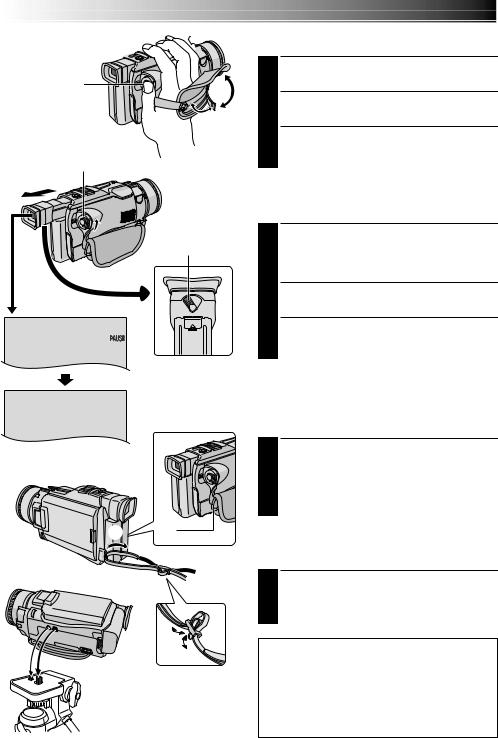
8 EN
Power Zoom Lever 



Recording Start/Stop button
Power Switch
 Shooting Mode
Shooting Mode
Switch
Dioptre
Adjustment
Control
PAUSE
GETTING STARTED (cont.)
Grip Adjustment
1 Separate the Velcro strip.
2 Pass your right hand through the loop and grasp the grip.
3 Adjust so that your thumb and fingers can easily operate the Recording Start/Stop Button and Power Zoom Lever. Refasten the Velcro strip.
Viewfinder Adjustment
1 Set the Power Switch to “ ” or “
” or “ ” while pressing down the Lock Button located on the switch. Set the Shooting Mode Switch to any position.
” while pressing down the Lock Button located on the switch. Set the Shooting Mode Switch to any position.
2 Pull out the viewfinder fully and adjust it manually for best viewability.
3 Turn the Dioptre Adjustment Control until the indications in the viewfinder are clearly focused.
Shoulder Strap Attachment
1 Following the illustration, thread the strap through the eyelet 1, then fold it back and thread it through the buckle 2. Repeat the procedure to attach the other end of the strap to the other eyelet 3, making sure the strap is not twisted.
 1 3
1 3
Tripod Mounting
 2
2
1 Align the screw and camera direction stud on the tripod with the camera’s mounting socket and stud hole. Then tighten the screw.
•Some tripods are not equipped with studs.
CAUTION:
When using a tripod, be sure to open and extend its legs fully to stabilise the camcorder. To prevent damage to the unit caused by falling over, do not use a smallsized tripod.
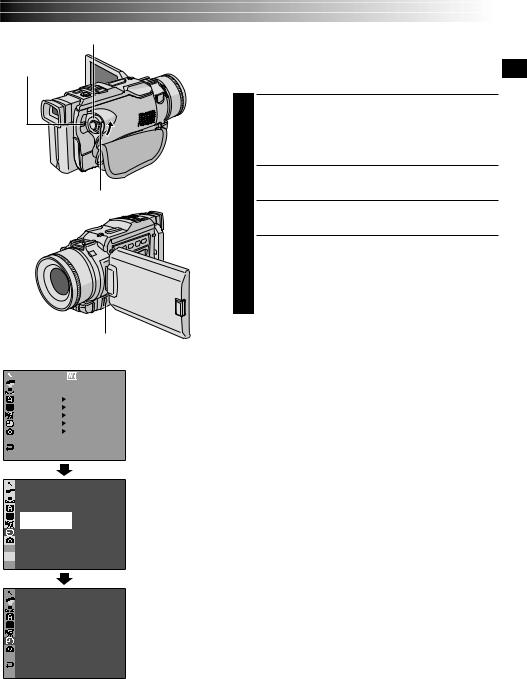
Power Switch
Power Lamp
Lock Button
|
|
|
|
MENU Wheel |
|
|
Display |
|
|||
|
|
|
|
|
|
|
FADER /WI PE |
|
F . WH I TE |
|
|
|
PROGRAM AE |
|
|
|
|
|
W. BALANCE |
|
|
|
|
|
CAMERA |
|
|
|
|
|
MANUAL |
|
|
|
|
|
SYSTEM |
|
|
|
|
|
D I SPLAY |
|
|
|
|
|
DSC |
|
|
|
|
|
|
|
|
|
|
|
END |
|
|
|
|
|
ON SCREEN |
– |
LCD / TV |
DISPLAY Menu |
|
|
|||||
|
|||||
|
|||||
|
DATE / T I ME |
– |
AUTO |
|
|
|
T I ME CODE |
– |
OFF |
|
|
|
CLOCK |
|
25 . 12 . 01 |
|
|
|
ADJ . |
|
17 : 30 |
|
|
 RETURN
RETURN
|
|
CLOCK |
|
|
|
|
|
|
|
|
|
|
|
||
|
|
|
|
|
|
||
|
|
|
25 |
. 12 |
. 01 |
||
|
|
ADJ . |
|
|
17 |
: 30 |
|
|
|
|
|
|
|
|
|
|
|
|
|
|
|
|
|
|
|
|
|
|
|
|
|
EN9
Date/Time Settings
The date/time is recorded onto the tape at all times, but its display can be turned on or off during playback
( pg. 39).
1 Set the Power Switch to “ ” while pressing down the Lock Button located on the switch, and open the LCD monitor fully or pull out the viewfinder fully. The power lamp lights and the camcorder is turned on.
” while pressing down the Lock Button located on the switch, and open the LCD monitor fully or pull out the viewfinder fully. The power lamp lights and the camcorder is turned on.
2 Press the MENU wheel. The Menu Screen appears.
3 Rotate the MENU wheel to select “ DISPLAY”. Press it and the DISPLAY Menu appears.
DISPLAY”. Press it and the DISPLAY Menu appears.
4 Rotate the MENU wheel to select “CLOCK ADJ.”. Press it and “day” is highlighted.
Rotate the MENU wheel to input the day. Press it. Repeat to input the month, year, hour and minute. Rotate the MENU wheel to select “1RETURN”, and press it twice. The Menu Screen closes.
Built-in Clock’s Rechargeable Lithium Battery
To store the date/time in memory, the clock’s rechargeable lithium battery is integrated in the camcorder. While the camcorder is connected to an AC outlet using the AC Power Adapter/Charger, or while the battery pack attached to the camcorder continues to supply power, the clock’s rechargeable lithium battery is always charged. However, if the camcorder is not used for approx. 3 months, the clock’s lithium battery will become discharged and the date/time stored in memory will be lost. When this occurs, first connect the camcorder to an AC outlet using the AC Power Adapter/Charger for over 24 hours to charge the clock’s rechargeable lithium battery. Then perform the date/time setting before using the camcorder.
Note that the camcorder can be used without setting the date/time.
NOTE:
Even if you select “CLOCK ADJ.”, if the parameter is not highlighted the camcorder’s internal clock continues to operate. Once you move the highlight bar to the first date/ time parameter (day), the clock stops. When you finish setting the minute and press the MENU wheel, the date and time begin operation from the date and time you just set.
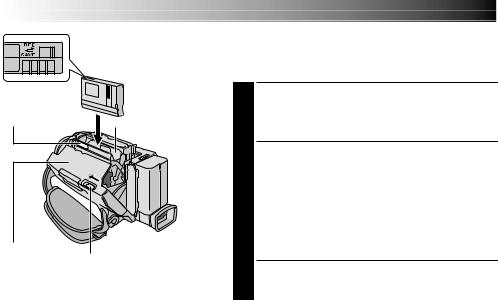
10 EN
Erase protection tab*
GETTING STARTED (cont.)
Loading/Unloading A Cassette
The camcorder needs to be powered up to load or eject a cassette.
Make sure the window side is facing out.
PUSH HERE
 Cassette holder
Cassette holder
Cassette |
|
holder cover |
OPEN/EJECT Switch |
* To Protect Valuable Recordings . . .
.... slide the erase protection tab on the back of the tape in the direction of “SAVE”. This prevents the tape from being recorded over. To record on this tape, slide the tab back to “REC” before loading it.
Be sure to press only the section labeled “PUSH HERE” to close the cassette holder; touching other parts may cause your finger to get caught in the cassette holder, resulting in injury or product damage.
NOTES:
1 Slide and hold OPEN/EJECT in the direction of the arrow then pull the cassette holder cover open until it locks. The cassette holder opens automatically.
•Do not touch internal components.
2 Insert or remove a tape and press “PUSH HERE” to close the cassette holder.
•Once the cassette holder is closed, it recedes automatically. Wait until it recedes completely before closing the cassette holder cover.
•When the battery’s charge is low, you may not be able to close the cassette holder cover. Do not apply force. Replace the battery with a fully charged one before continuing.
3 Close the cassette holder cover firmly until it locks into place.
Approximate recording time
Tape |
Recording mode |
|
|
|
|
|
SP |
LP |
|
|
|
30 min. |
30 min. |
45 min. |
|
|
|
60 min. |
60 min. |
90 min. |
|
|
|
80 min. |
80 min. |
120 min. |
|
|
|
●It takes a few seconds for the cassette holder to open. Do not apply force.
●If you wait a few seconds and the cassette holder does not open, close the cassette holder cover and try again. If the cassette holder still does not open, turn the camcorder off then on again.
●If the tape does not load properly, open the cassette holder cover fully and remove the cassette. A few minutes later, insert it again.
●When the camcorder is suddenly moved from a cold place to a warm environment, wait a short time before opening the cassette holder cover.
●Closing the cassette holder cover before the cassette holder comes out may cause damage to the camcorder.
●Even when the camcorder is switched off, a cassette can be loaded or unloaded. After the cassette holder is closed with the camcorder switched off, however, it may not recede. It is recommended to turn the power on before loading or unloading.
●When resuming recording, once you open the cassette holder cover a blank portion will be recorded on the tape or a previously recorded scene will be erased (recorded over) regardless of whether the cassette holder came out or not. See page 21 for information about recording from the middle of a tape.
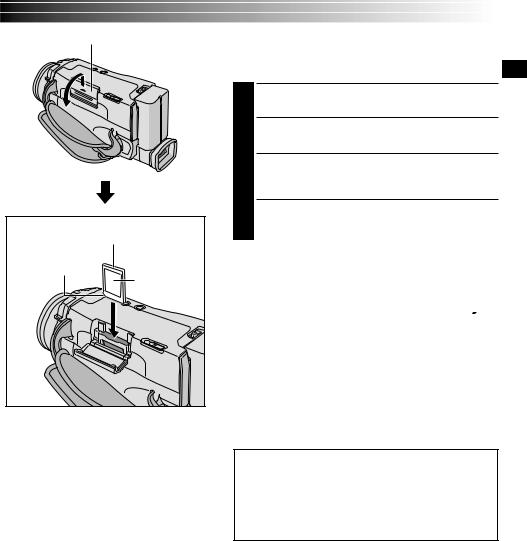
Card Cover
Memory card |
Clipped edge |
Label |
EN11
Loading A Memory Card
The provided MultiMediaCard is already inserted in the camcorder when you receive the camcorder.
1 Make sure the camcorder’s power is off.
2 Open the card cover (MEMORY CARD).
3 Insert the memory card clipped edge first.
•Do not touch the terminal on the reverse side of the label.
4 To close the card cover, push it until you hear a click.
To Unload A Memory Card . . .
.... in step 3 push the memory card, which then comes out of the camcorder automatically. Pull it out and close the card cover.
NOTES:
●Be sure to use only SD Memory Cards marked “
 ” or MultiMediaCards marked “
” or MultiMediaCards marked “




 ”.
”.
●Some brands of memory cards are not compatible with this camcorder. Before purchasing a memory card , consult its manufacturer or dealer.
●Before using a new memory card, it is necessary to FORMAT the card. pg. 47.
●Even if a memory card is inserted in the camcorder, the camcorder may not recognize it. In this case, remove the memory card once and insert it again.
ATTENTION:
Do not insert/remove the memory card while the camcorder is turned on, as this may cause the memory card to be corrupted or cause the camcorder to become unable to recognize whether or not the card is installed.
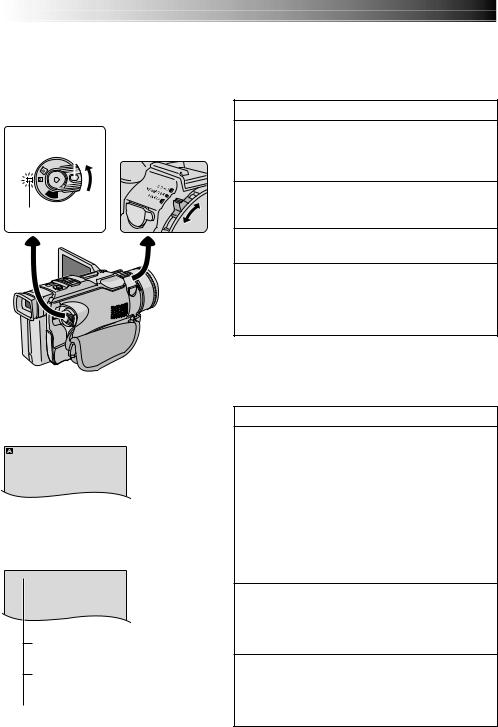
12 EN
To turn on the camcorder, first set the Power Switch to any operation mode except “OFF” while pressing down the Lock Button located on the switch, then pull out the viewfinder fully or open the LCD monitor fully.
Power Switch
|
Lock Button |
Shooting Mode Switch |
|
|
|
|
|
F
F
O
YALP
Power lamp
When the Power Switch is set to “ ”, “
”, “ ” appears. When set to “
” appears. When set to “ ” or “
” or “ ”, there is no indication.
”, there is no indication.
The following indications appear in the upper left corner, depending on the Shooting Mode Switch position.
UXGA
No display : When set to “VIDEO”
XGA or VGA : When set to “XGA/VGA”
 UXGA : When set to “UXGA”
UXGA : When set to “UXGA”
GETTING STARTED (cont.)
Operation Mode
Choose the appropriate operation mode according to your preference using the Power Switch and Shooting Mode Switch.
Power Switch Position
 (Manual):
(Manual):
Allows you to set various recording functions using the Menus. If you want more creative capabilities than Full Auto recording, try this mode.
 (Full Auto):
(Full Auto):
Allows you to record using NO special effects or manual adjustments. Suitable for standard recording.
OFF:
Allows you to switch off the camcorder.
 :
:
Allows you to play back a recording on the tape, to display an image stored in the memory card or to transfer a still image recorded on the tape or in the memory card to a computer.
Shooting Mode Switch Position
VIDEO:
•Allows you to record on a tape. Approx. 6 seconds
of a still image can be inserted between video recordings ( pg. 18).
•Zoom magnification over 10X is available ( pg. 20, 27).
•Allows you to record video on a tape and store still images in a memory card simultaneously ( pg. 24).
•Allows you to record moving images (successive
jitter-free still images) with superior quality on a tape ( pg. 22). The still images can also be processed on a PC or printed out.
XGA/VGA:
•Allows you to record still images in a memory card ( pg. 14, 19).
•File size:1024 x 768 pixels (XGA) or
640 x 480 pixels (VGA)
UXGA:
•Allows you to record still images in a memory card at high resolution ( pg. 14, 19). Suitable for recording still images with superior quality.
•File size:1600 x 1200 pixels
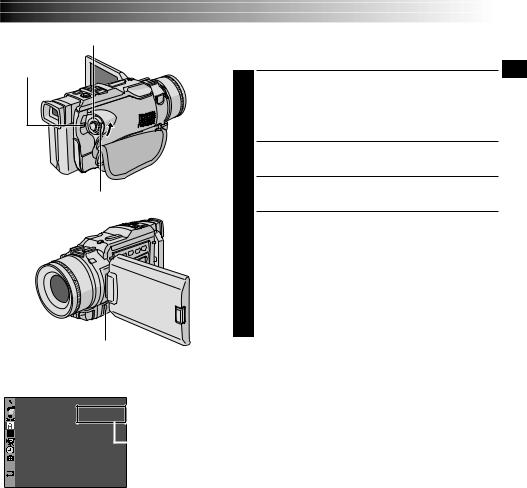
Power Switch
Power Lamp
Lock Button
MENU Wheel
Display
|
|
|
|
|
|
|
Menu Screen |
|
|
|
REC MODE |
– |
SP |
|
|
||
|
|
|
|
|
LP |
|
|
|
|
|
|
|
|
|
|
|
Sub Menu |
|
|
|
|
|
|
|
|
|
|
|
|
|
|
|
|
|
|
|
|
|
|
|
|
|
|
|
|
|
|
|
|
|
|
|
|
EN13
Recording Mode Setting
Set the tape recording mode depending on your preference.
1 Set the Power Switch to “ ” while pressing down the Lock Button located on the switch, and open the LCD monitor fully or pull out the viewfinder fully. The power lamp lights and the camcorder is turned on.
” while pressing down the Lock Button located on the switch, and open the LCD monitor fully or pull out the viewfinder fully. The power lamp lights and the camcorder is turned on.
2 Press the MENU wheel. The Menu Screen appears.
3 Rotate the MENU wheel to select “ CAMERA” and press it. The CAMERA Menu appears.
CAMERA” and press it. The CAMERA Menu appears.
4 Rotate the MENU wheel to select “REC MODE” and press it. The Sub Menu appears. Select “SP” or “LP” by rotating the MENU wheel and press it. Rotate the MENU wheel to select “1RETURN”, and press it twice. The Menu Screen closes.
•Audio Dubbing ( pg. 71) and Insert Editing
( pg. 72) are impossible on a tape recorded in the LP mode.
•“LP” (Long Play) is more economical, providing 1.5 times the recording time.
NOTES:
●If the recording mode is switched during recording, the playback picture will be blurred at the switching point.
●It is recommended that tapes recorded in the LP mode on this camcorder be played back on this camcorder.
●During playback of a tape recorded on another camcorder, blocks of noise may appear or there may be momentary pauses in the sound.
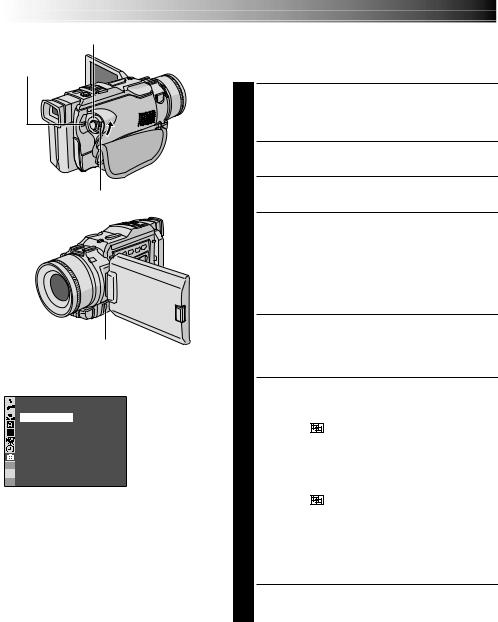
14 EN
Power Switch
Power Lamp
Lock Button
|
|
|
|
MENU Wheel |
|
|
|
Display |
|
||
|
|
QUAL I TY |
– |
F I NE |
Menu Screen |
|
|
||||
|
|
|
|||
|
|
S I ZE |
– |
XGA |
|
|
|
UXGA |
– |
AUTO |
|
|
|
|
|
|
|
 RETURN
RETURN
GETTING STARTED (cont.)
Picture Mode Setting
The Picture mode can be selected to best match your needs.
1 Set the Power Switch to “ ” while pressing down the Lock Button located on the switch, and open the LCD monitor fully or pull out the viewfinder fully. The power lamp lights and the camcorder turns on.
” while pressing down the Lock Button located on the switch, and open the LCD monitor fully or pull out the viewfinder fully. The power lamp lights and the camcorder turns on.
2 Press the MENU wheel. The Menu Screen appears.
3 Rotate the MENU wheel to select “  DSC” and press it. The DSC Menu appears.
DSC” and press it. The DSC Menu appears.
4
AUTO : |
|
|
or |
|
appears when the SNAPSHOT |
|
button is pressed ( pg. 19). |
||||
|
Automatically processes the image |
||||
|
according to the DOUBLE or ENLARGE |
||||
|
methods described below, depending on |
||||
|
the shooting situation or subject. |
||||
DOUBLE : |
|
|
appears ( pg. 19). |
||
|
Engages pixel-shift technology to double- |
||||
|
expose the image and generate a UXGA- |
||||
|
sized picture. |
||||
ENLARGE : |
|
|
appears ( pg. 19). |
||
Digitally enlarges the image to UXGA size.
7 Rotate the MENU wheel to select “ RETURN”, and press it twice. The Menu Screen closes.
RETURN”, and press it twice. The Menu Screen closes.

EN15
STORAGE CAPACITY
The number of storable images depends on the selected picture quality and size as well as the composition of the subjects in the images.
Approximate number of storable images
(with 16 MB MultiMediaCard)
SIZE |
|
|
QUALITY |
|
|
|
|
|
|
|
FINE |
|
STANDARD |
|
|
|
|
||
|
|
|
|
|
UXGA (1600 x 1200) |
|
20 |
|
60 |
|
|
|
|
|
XGA (1024 x 768) |
|
48 |
|
144 |
|
|
|
|
|
VGA (640 x 480) |
|
100 |
|
300 |
|
|
|
||
Approximate number of storable images |
||||
(with 8 MB MultiMediaCard) |
|
|
|
|
|
|
|
|
|
SIZE |
|
|
QUALITY |
|
|
|
|
|
|
|
FINE |
|
STANDARD |
|
|
|
|
||
|
|
|
|
|
UXGA (1600 x 1200) |
|
10 |
|
30 |
|
|
|
|
|
XGA (1024 x 768) |
|
24 |
|
72 |
|
|
|
|
|
VGA (640 x 480) |
|
50 |
|
150 |
|
|
|
|
|
NOTES:
●If the Shooting Mode Switch is set to “XGA/VGA” or “UXGA” during video recording, the camcorder stops video recording.
●The camcorder automatically zooms out to less than 2X when the Shooting Mode Switch is set to “UXGA”.
●With images shot in the UXGA mode . . .
—the shutter speed is applicable only up to 1/500 in the “SPORTS” mode ( pg. 35).
—Sepia and Monotone cannot be activated.
●If “DOUBLE” is selected in the UXGA mode, images may not be processed properly in the following situations:
—when the subject has no contrast (difference in brightness and darkness).
—when shooting in a dark place.
—when the subject contains identical patterns that are regularly repeated.
—when shooting under a flickering light such as a fluorescent light or candlelight.
—when the subject is moving rapidly.
—when there is excessive camera-shake.
●If “AUTO” is selected in the UXGA mode, and any of the shooting situations listed above are encountered, the camcorder will automatically process the image using the ENLARGE method.
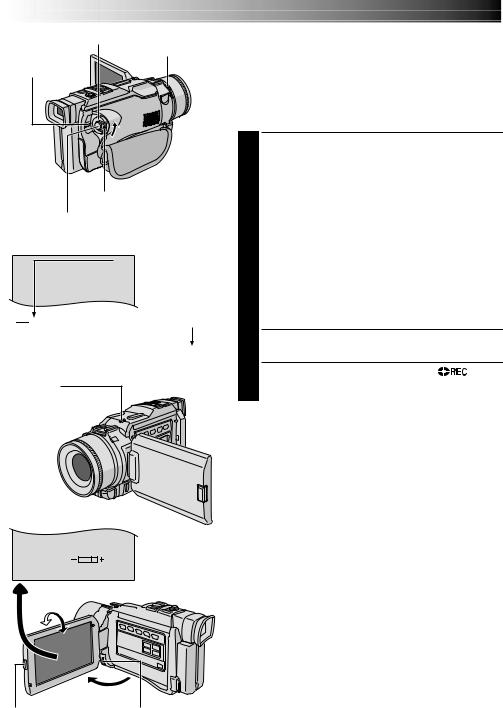
16 EN |
RECORDING Basic Recording For Video |
Power Switch |
Shooting |
|
Mode Switch |
Power lamp
Lock Button
Recording Start/Stop Button
Display
25min Tape remaining time indicator (Approximate)
min  90 min
90 min  89 min
89 min  3 min
3 min
(Now
calculating)
0 min 1 min
1 min 2 min
2 min
(Blinking) (Blinking) (Blinking)
Tally lamp (lights while recording is in progress)
NOTE:
You should already have performed the procedures listed below. If not, do so before continuing.
●Power ( pg. 6)
●Grip Adjustment ( pg. 8)
●Viewfinder Adjustment ( pg. 8)
●Load A Cassette ( pg. 10)
●Recording Mode Setting ( pg. 13)
1 Set the Shooting Mode Switch to “VIDEO”, then set the Power Switch to “ ” or “
” or “ ” while pressing down the Lock Button located on the switch. Make sure “CAMERA MODE” is set to “VIDEO” in the Menu Screen ( pg. 26, 27).
” while pressing down the Lock Button located on the switch. Make sure “CAMERA MODE” is set to “VIDEO” in the Menu Screen ( pg. 26, 27).
Shooting while using the viewfinder: Make sure the LCD monitor is closed and locked. Pull out the viewfinder fully.
•Be sure to pull out the viewfinder until you hear a click, otherwise it may be pushed back in during use.
Shooting while using the LCD monitor: Make sure the viewfinder is pushed back in. Press PUSH OPEN and open the LCD monitor fully. Tilt it upward/ downward for best viewability.
•The power lamp lights and the camcorder enters the Record-Standby mode. “PAUSE” is displayed.
Press the Recording Start/Stop Button. “ |
” |
2 appears while recording is in progress. |
|
To Stop Recording . . .
.... press the Recording Start/Stop Button. The camcorder re-enters the Record-Standby mode.
BR I GHT
180° 90° 
To Adjust The Brightness Of The Display
.... rotate the MENU wheel until the bright level indicator on the display moves and the appropriate brightness is reached.
•It is also possible to adjust the brightness of the viewfinder.
PUSH OPEN Button |
MENU Wheel |
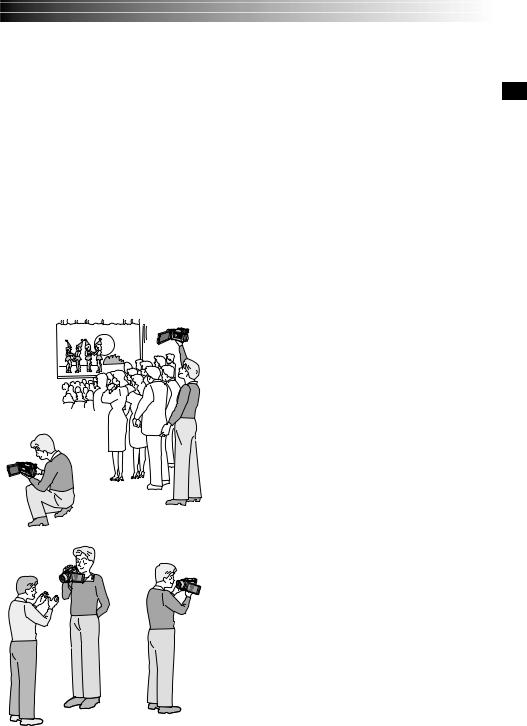
EN17
NOTES:
●When you use the LCD monitor outdoors in direct sunlight, the LCD monitor may be difficult to see. If this happens, use the viewfinder instead.
●The image will not appear simultaneously in the LCD monitor and the viewfinder except during Interface Shooting.
●The cassette holder cannot be opened unless a power supply is attached.
●There may be a delay after you open the cassette holder cover until the cassette holder opens. Do not use force.
●Once the cassette holder is closed, it recedes automatically. Wait until it recedes completely before closing the cassette holder cover.
●The time required to calculate and display the remaining tape length, and the accuracy of the calculation, may vary according to the type of tape used.
●“TAPE END” appears when the tape reaches its end, and the power goes off automatically if left in this condition for 5 minutes. “TAPE END” also appears when a cassette at its end is loaded.
●If the Record-Standby mode continues for 5 minutes, the camcorder’s power shuts off automatically. To turn the camcorder on again, push back and pull out the viewfinder again or close and re-open the LCD monitor.
●When a blank portion is left between recorded scenes on the tape, the time code is interrupted and errors may occur when editing the tape. To avoid this, refer to “Recording from the middle of a tape” ( pg. 21).
●During recording, sound is not heard from the speaker. To hear the sound, connect optional headphones to the PHONE connector. The sound volume is at the level it was adjusted to during playback ( pg. 38).
●To turn the tally lamp or beep sounds off, pg. 26, 29.
JOURNALISTIC SHOOTING
In some situations, different shooting angles may provide more dramatic results. Hold the camcorder in the desired position and tilt the LCD monitor in the most convenient direction. It can rotate 270° (90° downward, 180° upward).
INTERFACE SHOOTING
The person you shoot can view himself/herself in the LCD monitor, and you can even shoot yourself while viewing your own image in the LCD monitor.
Open the LCD monitor and tilt it upward to 180° so that it faces forward. When the LCD monitor is tilted upward to an angle of over approx. 105°, the monitor image is inverted vertically. If the viewfinder is pulled out at that time, it also switches on.
Point the lens toward the subject (yourself when selfrecording) and start recording.
Self-Recording
During Interface Shooting, the monitor image and indications do not appear inverted as they would when viewing a mirror.
NOTES:
● During Interface Shooting, the “Tape Running” indicator and warning indications ( pg. 87, 88) are the only ones that are shown; they appear reversed in the display as they would when viewing a mirror, but are not reversed in the recording.
●The tape remaining indicator does not appear during interface shooting. However, when the remaining time
reaches 2 minutes, the indicator appears showing the remaining time: 


 (blinking)
(blinking) 

 (blinking)
(blinking) 

 (blinking)
(blinking)

18 EN |
RECORDING Basic Recording For Video (cont.) |
|
Power Switch |
Shooting |
Snapshot (For Video Recording) |
|
Mode Switch |
This feature lets you record still images that look like |
|
|
|
SNAPSHOT |
|
photographs onto a tape. |
|
SNAPSHOT MODE SELECTION |
|
Button |
|
|
|
1 |
Set the Shooting Mode Switch to “VIDEO”, then set the |
|
|
Power Switch to “ ” while pressing down the Lock |
|
|
Button located on the switch. Pull out the viewfinder |
|
|
fully or open the LCD monitor fully. |
|
2 Press the MENU wheel. The Menu Screen appears. |
|
Lock Button |
3 |
Rotate the MENU wheel to select “ CAMERA”. Press |
it and the CAMERA Menu appears.
Display
Menu Screen
SNAP MODE – P I N–UP
FRAME
FULL
MULT I – 4
MULT I – 9
NEGA POS I
FULL Snapshot mode
with no frame* √
MULTI-4
Multi-Analyser 4
MULTI-9
Multi-Analyser 9
PIN-UP Pin-Up mode √
NEGA POSI Nega/Posi mode* √
FRAME Snapshot mode with frame* √
* There is the sound effect of a shutter closing.
√When “FULL”, “FRAME”, “PIN-UP” or “NEGA
POSI” is selected, snapshot recording will always be performed with higher quality ( pg. 22) even if “CAMERA MODE” is set to “VIDEO”.
●To remove the shutter sound, “BEEP” on pg. 29.
●If Digital Zoom is used while in the “MULTI-4” or “MULTI- 9” mode, Snapshot recording will be performed with 10X magnification.
●If Snapshot recording is not possible, “PHOTO” blinks when SNAPSHOT is pressed.
●If Programme AE with special effects ( pg. 34) is engaged, certain modes of Programme AE with special effects are disabled during Snapshot recording. In such a case, the icon blinks.
●If SNAPSHOT is pressed when “DIS” is set to “ON” ( pg. 27), the Stabiliser will be disabled.
●To dub images recorded on a tape to a memory card,pg. 60.
●When shooting in the Multi-Analyser 4 or Multi-Analyser 9 modes, the optional flash ( pg. 83) will not light.
●During playback as well, all snapshot modes except Nega/
Posi mode are available when “ |
|
|
|
COPY” is set to |
“OFF” in the Menu Screen ( pg. 39). |
|
|
||
●When a headphone set is connected to the PHONE connector, the shutter sound is not heard from the speaker, however it is recorded onto the tape.
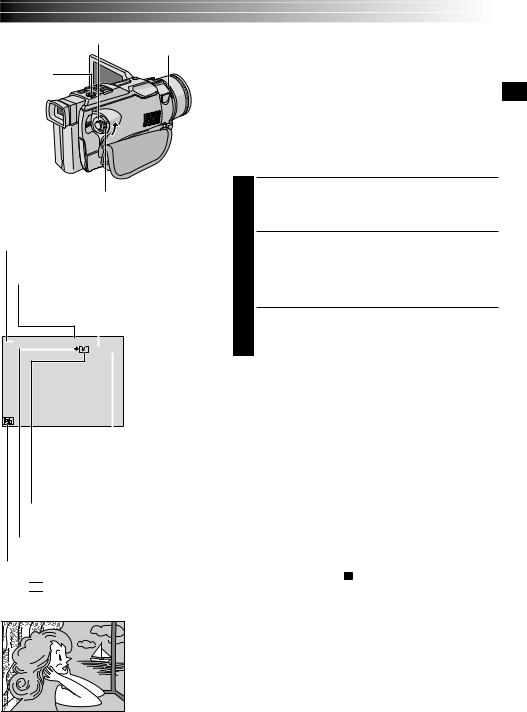
RECORDING Basic Recording For Digital Still Camera (D.S.C.) EN19
Power Switch |
Shooting |
|
Mode Switch |
SNAPSHOT |
|
Button |
|
Lock Button
Picture Size
Displays the file size of the stored image: UXGA, XGA or VGA ( pg. 14).
Picture Quality
Displays the quality of the stored image: FINE or STD (standard) (in order of quality) ( pg. 14).
Number of shots taken
Displays the number of images that have already been shot.
|
UXGA |
F I NE |
|
|
|
Display |
|||
|
|
|
|
||||||
|
|
|
|
|
|
|
|
|
|
|
|
|
|
|
|
10 / 24 |
|||
|
|
|
|
|
|
|
|||
|
|
|
|
|
|
|
|
|
|
Total number of shots
Displays the approximate total number of shots that can be stored, including those already taken. The number increases or decreases depending on the shots stored, the Picture mode, Shooting mode, etc.
Card icon
Appears during shooting and blinks when a memory card is not loaded.
Shooting icon
Appears and blinks during shooting.
UXGA Mode icon
Displays the process utilized to create the UXGA size image: 




 (DOUBLE) or
(DOUBLE) or  (ENLARGE) ( pg. 14).
(ENLARGE) ( pg. 14).
Snapshot mode with no frame
There is the sound of a shutter closing.
Basic Shooting (Snapshot)
You can use your camcorder as a Digital Still Camera for taking snapshots.
NOTE:
You should already have performed the procedures listed below. If not, do so before continuing.
●Power ( pg. 6)
●Grip Adjustment ( pg. 8)
●Viewfinder Adjustment ( pg. 8)
●Loading A Memory Card ( pg. 11)
●Picture Mode Setting ( pg. 14)
1 Set the Shooting Mode Switch to “XGA/VGA” or “UXGA”, then set the Power Switch to “ ” or “
” or “ ” while pressing down the Lock Button located on the switch. Open the LCD monitor fully or pull out the viewfinder fully.
” while pressing down the Lock Button located on the switch. Open the LCD monitor fully or pull out the viewfinder fully.
2 Press SNAPSHOT halfway. The screen becomes a still image, which is captured into the camcorder’s memory. However, it is not recorded until SNAPSHOT is pressed fully.
•At this moment, if you release SNAPSHOT, snapshot recording will be cancelled.
3 Press SNAPSHOT fully.
The image is recorded in the memory card .
•Still images are recorded in the snapshot mode with no frame.
To Delete Unwanted Still Images . . .
..... when unwanted still images are stored in the memory card or its memory is full, refer to “Deleting Images” ( pg. 45) and delete unwanted still images.
To Remove The Shutter Sound . . .
..... when you do not want to hear the shutter sound, set “BEEP” to “OFF” in the Menu Screen ( pg. 26, 29). The sound is no longer heard from the speaker.
NOTES:
●Even if “DIS” is set to “ON” ( pg. 27), the Stabiliser will be disabled.
●If Snapshot recording is not possible, “PHOTO” blinks when SNAPSHOT is pressed.
●If Programme AE with special effects ( pg. 34) is engaged, certain modes of Programme AE with special effects are disabled during Snapshot recording. In such a case, the icon blinks.
●If shooting is not performed for approx. 5 minutes when the Power Switch is set to “  ” or “
” or “ ” and power is supplied from the battery pack, the camcorder shuts off automatically to save power. To perform shooting again, close the LCD monitor and re-open it. When using the viewfinder, push back it in and pull it out again.
” and power is supplied from the battery pack, the camcorder shuts off automatically to save power. To perform shooting again, close the LCD monitor and re-open it. When using the viewfinder, push back it in and pull it out again.
●The Motor Drive mode ( pg. 18) is disabled when the Shooting Mode Switch is set to “XGA/VGA” or “UXGA”.
●When a headphone set is connected to the PHONE connector, the shutter sound is not heard from the speaker.
●Still images taken are compliant to DCF (Design rules for Camera File systems). They do not have any compatibility with devices which are not compliant to DCF.
●In the XGA mode, images shot using a 680,000-pixel Progressive Scan CCD (effective area: 630,000 pixels, 962 x 654 pixels) are converted and stored in the XGA mode file size (1024 x 768 pixels).
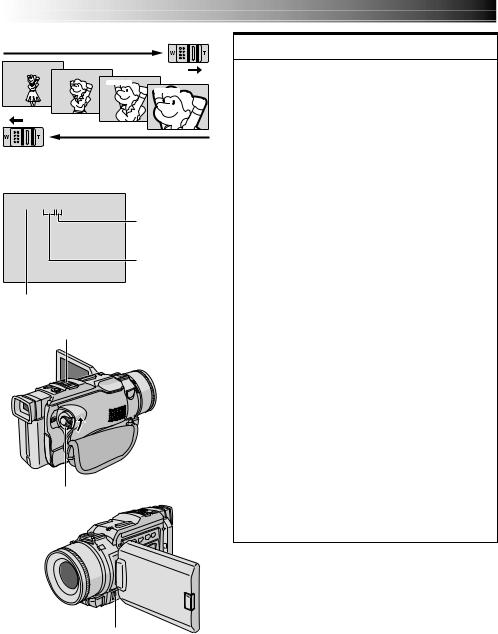
20 EN |
RECORDING Basic Recording For Video And D.S.C. |
Zoom in (T: Telephoto)
1 x W T
T
10 x W T
T
20 x W T
T
40 x W T
T
Zoom out (W: Wide angle)
Zoom display
10 x W

 T
T
Digital zoom zone
10X (optical) zoom zone
Approximate zoom ratio
Power Zoom Lever
Power Switch
FEATURE: Zooming
PURPOSE:
To produce the zoom in/out effect, or an instantaneous change in image magnification.
OPERATION:
Zoom In
Slide the Power Zoom Lever towards “T”.
Zoom Out
Slide the Power Zoom Lever towards “W”.
The further you slide the Power Zoom Lever, the quicker the zoom action.
NOTES:
●Focusing may become unstable during Zooming. In this case, set the zoom while in Record-Standby,
lock the focus by using the manual focus
( pg. 25), then zoom in or out in Record mode.
●Zooming is possible to a maximum of 300X, or it
can be switched to 10X magnification using the optical zoom ( pg. 27).
●Zoom magnification of over 10X is done through Digital image processing, and is therefore called Digital Zoom.
●During Digital zoom, the quality of image may suffer.
●Digital zoom cannot be used in the following cases:
•When digital image processing, such as Picture Wipe/Dissolve ( pg. 32, 33) or Video Echo
( pg. 34, 35), is activated.
•When the Shooting Mode Switch is set to “UXGA” or “XGA/VGA” ( pg. 12).
•When “CAMERA MODE” is set to “DUAL” in the Menu Screen ( pg. 26, 27).
•When “CAMERA MODE” is set to “PS-VIDEO”
and “WIDE MODE” is set to “PS-WIDE” in the Menu Screen ( pg. 26, 27).
●Macro shooting (as close as approx. 5 cm to the subject) is possible when the Power Zoom Lever is set all the way to “W”. Also see “TELE MACRO” in the Menu Screen on page 28.
MENU Wheel
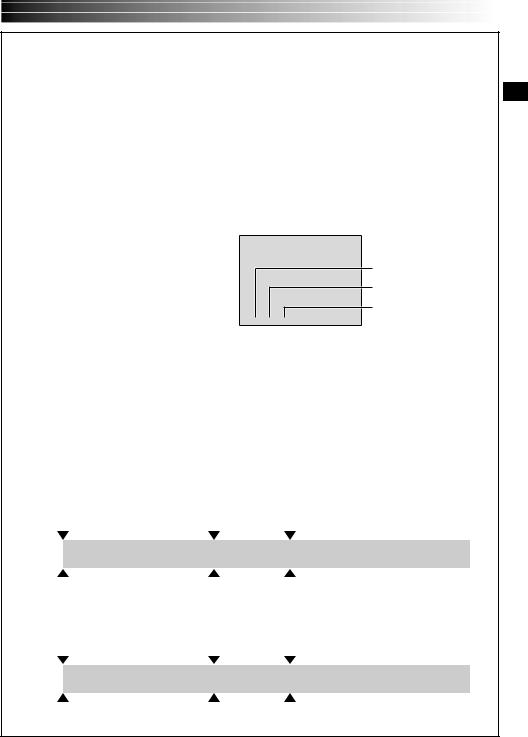
EN21
NOTE: Recording From The Middle Of A Tape
Time Code
During recording, a time code is recorded on the tape. This code is to confirm the location of the recorded scene on the tape during playback.
If recording starts from a blank portion, the time code begins counting from “00:00:00” (minute:second:frame). If recording starts from the end of a previously recorded scene, the time code continues from the last time code number.
To perform Random Assemble Editing ( pg. 65 – 70), time code is necessary. If during recording a blank portion is left partway through the tape, the time code is interrupted. When recording is resumed, the time code starts counting up again from “00:00:00”. This means the camcorder may record the same time codes as those existing in a previously recorded scene. To prevent this, perform “Recording From The Middle of A Tape” below in the following cases;
•When shooting again after playing back a recorded tape.
•When power shuts off during shooting.
•When a tape is removed and re-inserted during shooting.
•When shooting using a partially recorded tape.
•When shooting on a blank portion located partway through the tape.
•When shooting again after shooting a scene then opening/closing the cassette holder cover.
Display
 12 : 34 : 24
12 : 34 : 24
Frames are not displayed during recording.
Minutes
Seconds
Frames
(25 frames = 1 second)
Recording From The Middle Of A Tape
1.Play back a tape or use Blank Search ( pg. 41) to find the spot at which you want to start recording, then engage the Still Playback mode ( pg. 38).
2.Set the Power Switch to “ ” or “
” or “ ” while pressing down the Lock Button located on the switch, then start recording.
” while pressing down the Lock Button located on the switch, then start recording.
NOTES:
●The time code cannot be reset.
●During fast-forwarding and rewinding, the time code indication does not move smoothly.
●The time code is displayed only when “TIME CODE” is set to “ON” ( pg. 29, 39).
When a blank portion is recorded on a tape
Time code |
|
|
Time code |
Time code |
|
|||
00:00:00 |
|
|
05:43:21 |
00:00:00 |
|
|||
|
|
|
|
|
|
|
|
|
Tape |
|
Already recorded scene |
|
Blank |
|
|
Newly recorded scene |
|
|
|
|
|
|
|
|||
Shooting start point |
Shooting stop point |
Shooting start point |
||||||
Proper recording |
|
|
|
|
|
|
||
Time code |
|
|
Time code |
Time code |
|
|||
00:00:00 |
|
|
05:43:21 |
05:44:00 |
|
|||
|
|
|
|
|
||||
Tape |
|
Already recorded scene |
|
New scene |
|
Latest scene |
||
|
|
|
|
|
|
|
|
|
Shooting start point |
Shooting start point |
Shooting start point |
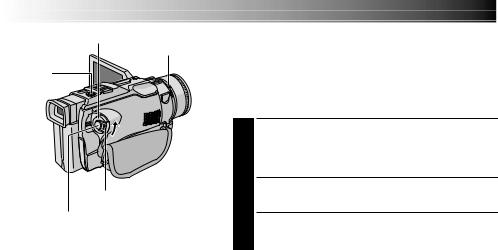
22 EN |
RECORDING |
|
Power Switch Shooting |
|
Mode Switch |
SNAPSHOT |
|
Button |
|
Lock Button
Recording Start/Stop Button
Advanced Features For Video And D.S.C.
Progressive Mode Recording
This mode lets you record moving images (successive jitter-free still images) onto a tape. Images can then played back jitter-free, with superior quality. High-resolution still images can also be processed on a personal computer or can be printed out ( pg. 55).
1 Set the Shooting Mode Switch to “VIDEO”, then set the Power Switch to “ ” while pressing down the Lock Button located on the switch. Pull out the viewfinder fully or open the LCD monitor fully.
” while pressing down the Lock Button located on the switch. Pull out the viewfinder fully or open the LCD monitor fully.
2 Set “CAMERA MODE” to “PS-VIDEO” in the Menu Screen ( pg. 26, 27).
3 To start Progressive Mode Recording, press the Recording Start/Stop Button.
To End Progressive Mode Recording . . .
.... press the Recording Start/Stop Button. The camcorder enters the Record-Standby mode.
NOTES:
●When an image recorded using the Progressive Mode is played back, the image may not look natural.
●When “CAMERA MODE” is set to “PS-VIDEO”, Picture Wipe/Dissolve ( pg. 32) and some Programme AE with special effects ( pg. 34) cannot be used.
●If SNAPSHOT is pressed in the PS-VIDEO mode, a snapshot will be recorded with higher quality than in
VIDEO mode. However, “MULTI-4” and “MULTI-9” cannot be used ( pg. 18).
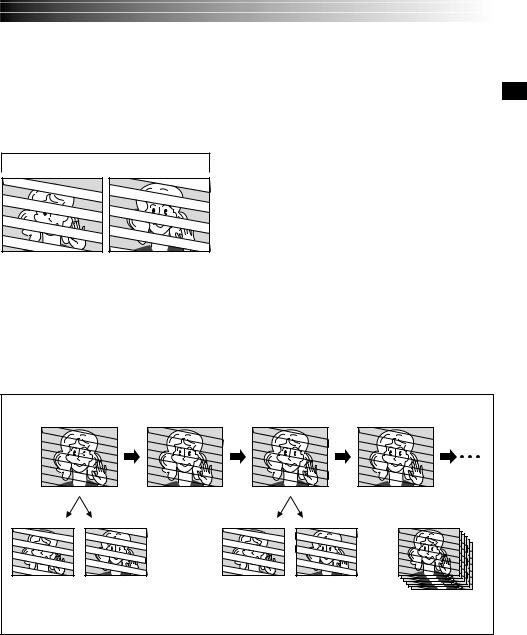
EN23
Description of Progressive Scan CCD
Progressive Scan is a special image sensing method which, unlike conventional interlace scanning, is able to pick up all the lines of picture information in one Scan. Since the Progressive Scan CCD is capable of outputting 50 full Frames* per second — twice the amount of conventional systems — it is able to deliver a high quality picture even when its output signal is converted to a format that can be viewed on a TV screen.
*A PAL TV screen image is composed of 25 Frames per second. 1 Frame is made up of 2 Fields.
|
1 Frame |
1. Regular shooting of moving images |
Scan A |
Scan B |
Records 25 odd and 25 even image Fields, for a total of 50 |
|
|
per second. Since there is a time lag between an odd and |
|
|
even Field, when they are combined to make 1 Frame the |
|
|
part of the image that is moving appears as image jitter. |
|
|
However, during normal playback, the moving picture |
|
|
looks smooth and natural. |
2. Progressive mode shooting of moving images (Progressive Mode Recording pg. 22)
Scan A is recorded, divided into an oddand even-number Field, and then Scan B is skipped. Scans C and D are handled in the same way as Scans A and B, as illustrated below, thereby recording 25 Frames per second.
Since each recorded oddand even-number Field originates from the same Scan there is no time lag between them, and so when they are combined into a Frame and a still image is displayed on a TV or PC monitor the picture does not look jittery. However, when moving images are played back, the picture can look unnatural.
Scan A |
Scan B |
Scan C |
Scan D |
||
|
|
Skip |
|
|
Skip |
Odd-number |
Even-number |
|
Odd-number |
Even-number |
|
Field |
Field |
|
Field |
Field |
25 Frames per second |
|
|
|
|
|
|
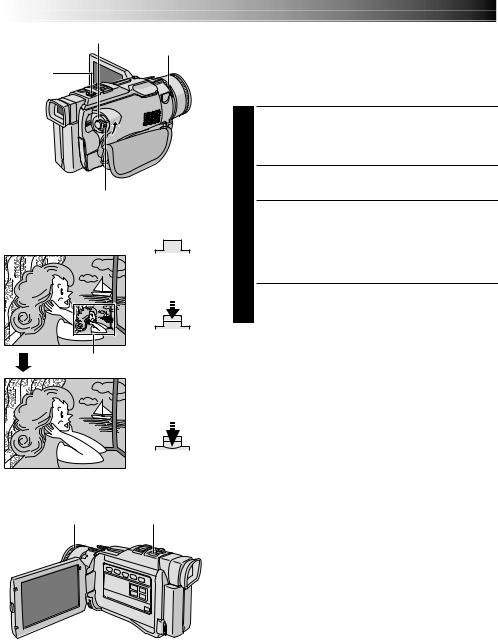
24 EN RECORDING Advanced Features For Video And D.S.C. (cont.)
Power Switch |
Shooting |
|
Mode Switch |
SNAPSHOT |
|
Button |
|
Lock Button
SNAPSHOT Button
Video image
Released position
Half-pressed position
Still image
Fully-pressed
position
Dual Shooting
Lets you record images on a tape and store still images in a memory card simultaneously. In other words, it is possible to store still images in the memory card without interrupting image recording on the tape.
1 Set the Shooting Mode Switch to “VIDEO”, then set the Power Switch to “ ” while pressing down the Lock Button located on the switch. Pull out the viewfinder fully or open the LCD monitor fully.
” while pressing down the Lock Button located on the switch. Pull out the viewfinder fully or open the LCD monitor fully.
2 Set “CAMERA MODE” to “DUAL” in the Menu Screen ( pg. 26, 27).
3 While recording to a tape, press SNAPSHOT halfway. A still image is displayed in the lower right corner of the screen where the video image being recorded is displayed.
•At this moment, if you release SNAPSHOT, snapshot recording will be cancelled.
4 Press SNAPSHOT fully. The displayed still image is stored in the memory card.
NOTES:
●If SNAPSHOT is pressed in the Record-Standby mode, only a still image is stored in the memory card. Video recording does not take place.
●If SNAPSHOT is pressed when “DIS” is set to “ON” ( pg. 27), the Stabiliser will be disabled.
●The Stabiliser is less effective in the DUAL mode than in other modes.
●Still images are stored in the memory card in VGA mode file size ( pg. 12).
●When “CAMERA MODE” is set to “DUAL”, all Fade/
Wipe Effects and some Programme AE with special effects cannot be used ( pg. 32 – 35).
●The optional flash ( pg. 3, 83) will not light during video recording.
FOCUS Ring |
FOCUS Button |
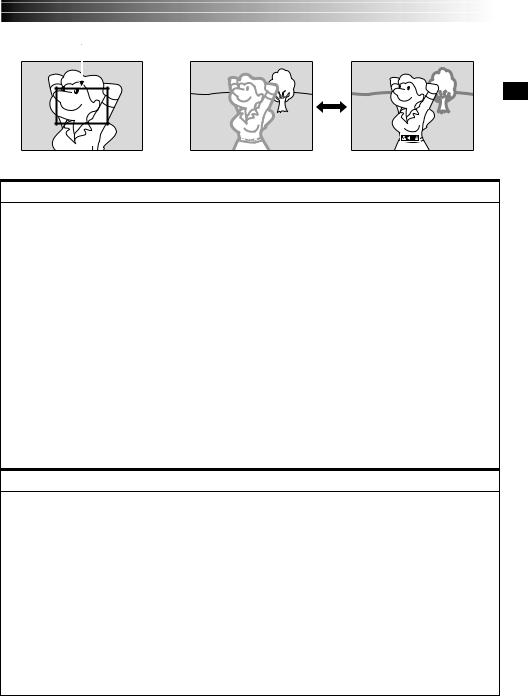
EN25
Focus detection zone |
While focusing on a further |
||
|
subject |
||
|
|
|
|
|
|
|
|
While focusing on a nearer subject
FEATURE: Auto Focus
PURPOSE:
The camcorder’s Full Range AF system offers continuous shooting ability from close-up (as close as approx. 5 cm to the subject) to infinity.
However, correct focus may not be obtainable in the situations listed below (in these cases use manual focusing):
•When two subjects overlap in the same scene.
•When illumination is low.*
•When the subject has no contrast (difference in brightness and darkness), such as a flat, one-colour wall, or a clear, blue sky.*
•When a dark object is barely visible in the viewfinder.*
•When the scene contains minute patterns or identical patterns that are regularly repeated.
•When the scene is affected by sunbeams or light reflecting off the surface of a body of water.
•When shooting a scene with a high-contrast background.
* The following low-contrast warnings appear blinking:  ,
,  ,
,  and
and 
NOTES:
●If the lens is smeared or blurred, accurate focusing is not possible. Keep the lens clean, wiping with a piece of soft cloth if it gets dirty. When condensation occurs, wipe with a soft cloth or wait for it to dry naturally.
●When shooting a subject close to the lens, zoom out first ( pg. 20). If zoomed-in in the auto focus
mode, the camcorder may automatically zoom out depending on the distance between the camcorder and the subject. This will not occur when “TELE MACRO” ( pg. 28) is activated.
FEATURE: Manual Focus
PURPOSE:
To obtain correct focus.
OPERATION:
1)If you are using the viewfinder, you should already have made the necessary viewfinder adjustments ( pg. 8).
2)Set the Power Switch to “ ” while pressing down the Lock Button located on the switch and set the Shooting Mode Switch to “VIDEO”, then press FOCUS. The manual focus indicator appears.
” while pressing down the Lock Button located on the switch and set the Shooting Mode Switch to “VIDEO”, then press FOCUS. The manual focus indicator appears.
3)To focus on a farther subject, rotate the Focus Ring clockwise. “ ” appears and blinks.
” appears and blinks.
To focus on a nearer subject, rotate the Focus Ring counterclockwise. “ ” appears and blinks.
” appears and blinks.
To reset to Auto Focus, press FOCUS or set the Power Switch to “ ”.
”.
NOTES:
●Be sure to focus the lens in the maximum telephoto position when you use the Manual Focus mode. If you focus in on a subject in the wide-angle position, sharply focused images cannot be obtained when zoomed up because the depth-of-field is reduced at longer focal lengths.
●When the focus level cannot be adjusted any further or closer, “ ” or “
” or “ ” will blink.
” will blink.
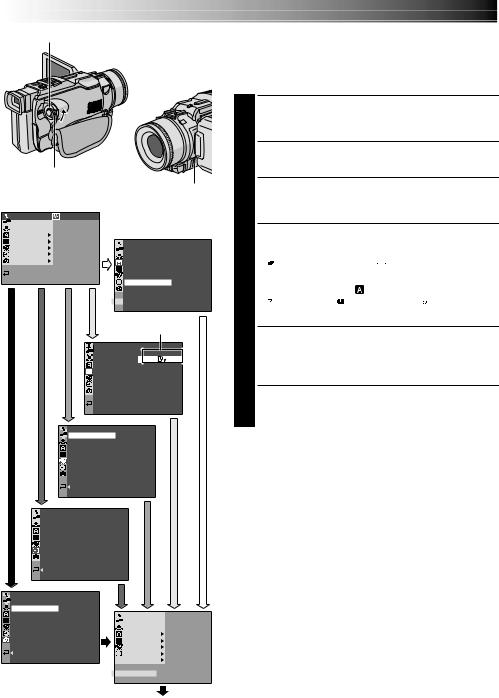
26 EN RECORDING Advanced Features For Video And D.S.C. (cont.)
Power Switch Using Menus For Detailed Adjustment
Lock Button
MENU Wheel
Display
|
|
|
FADER /WI PE |
F . WH I TE |
Menu Screen |
|
|
|||
|
|
|
|
|
||||||
|
|
|
|
|||||||
|
|
|
PROGRAM AE |
|
|
|
|
|
|
|
|
|
|
W. BALANCE |
|
|
|
|
|
|
|
|
|
|
CAMERA |
|
|
|
|
|
|
|
|
|
MANUAL |
|
|
|
|
|
|
||
|
|
|
SYSTEM |
|
|
REC MODE |
|
– |
SP |
|
|
|
|
D I SPLAY |
|
|
SOUND MODE |
|
– |
12B I T |
|
|
|
|
DSC |
|
|
ZOOM |
|
– |
40 x |
|
|
|
|
|
|
|
|
SNAP MODE |
|
– |
FULL |
|
|
|
END |
|
|
|
GA I N UP |
|
– |
AGC |
|
|
|
|
|
|
|
CAMERA MODE– |
V I DEO |
||
 RETURN
RETURN
|
Sub Menu |
D I S |
– OFF |
|
ON |
|
|
|
|
|
|
|
|
|
|
|
|
|
|
|
|
|
|
|
|
|
|
|
|
|
|
|
|
|
|
|
|
|
|
BEEP |
– |
MELODY |
|||
|
|
|
|
TALLY |
– |
ON |
|||
|
|
|
|
DEMO MODE |
– |
ON |
|||
|
|
|
|
|
|
|
|
|
|
|
|
|
|
|
|
|
|
|
|
|
|
|
|
RETURN |
|
|
|||
|
|
|
|
|
|
|
|
|
|
|
|
|
|
|
ON |
SCREEN |
– |
LCD / TV |
||||||
|
|
|
|
|
|
DATE / T I ME |
– |
ON |
||||||
|
|
|
|
|
|
T I ME |
CODE |
– |
OFF |
|||||
|
|
|
|
|
|
CLOCK |
ADJ . |
|
25 . 12 . 01 |
|
||||
|
|
|
|
|
|
|
||||||||
|
|
|
|
|
|
|
|
|
|
17 : 30 |
|
|||
|
|
|
|
|
|
|
|
|
|
|
|
|
|
|
|
|
|
|
|
|
RETURN |
|
|
|
|
||||
|
|
|
|
|
|
|
|
|
||||||
|
|
QUAL I TY |
|
– |
F I NE |
|
|
|
|
|||||
|
|
|
|
|
|
|
||||||||
|
|
S I ZE |
|
– |
XGA |
|
|
|
|
|||||
|
|
UXGA |
|
– |
AUTO |
|
|
|
FADER /WI PE |
|||||
|
|
|
|
|
|
|
|
|
|
|
|
|
|
PROGRAM AE |
|
|
|
|
|
|
|
|
|
|
|
|
|
|
W. BALANCE |
|
|
|
|
|
|
|
|
|
|
|
|
|
|
CAMERA |
|
|
|
|
|
|
|
|
|
|
|
|
|
|
MANUAL |
|
|
|
|
|
|
|
|
|
|
|
|
|
|
SYSTEM |
|
|
RETURN |
|
|
|
|
|
|
|
|
D I SPLAY |
|||
 DSC
DSC
 END
END
This camcorder is equipped with an easy-to-use, on-screen menu system that simplifies many of the more detailed camcorder settings ( pg. 27 – 29) .
1 Set the Power Switch to “ ” while pressing down the Lock Button located on the switch, then pull out the viewfinder fully or open the LCD monitor fully.
” while pressing down the Lock Button located on the switch, then pull out the viewfinder fully or open the LCD monitor fully.
2 Press the MENU wheel. The Menu Screen appears.
3 Rotate the MENU wheel to select the desired function menu, and press it. The selected function menu appears.
Function menu setting depends on the function. |
|||||||||||||||
4 If you have selected “ |
|
|
|
FADER/WIPE”, |
|||||||||||
|
|
|
|||||||||||||
“ |
|
PROGRAM AE” or “ |
|
W. BALANCE” . . . |
|||||||||||
|
|
||||||||||||||
.... see pg. 27. |
|
|
|
|
|
|
|
|
|
|
|||||
If you have selected “ |
|
|
CAMERA”, “ |
|
|
MANUAL”, |
|||||||||
|
|
|
|
||||||||||||
|
|
|
|
||||||||||||
“ |
|
|
SYSTEM”, “ |
|
DISPLAY” or “ |
|
|
DSC” . . . |
|||||||
|
|
|
|
|
|||||||||||
.... go to step 5.
5 Rotate the MENU wheel to select the desired function and press it. The Sub Menu appears.
Then, rotate the MENU wheel to select the parameter, and press it. Selection is complete.
6 Rotate the MENU wheel to select “1RETURN” and press it twice. The Menu Screen closes.
•The  icon represents “END”.
icon represents “END”.
Normal Screen
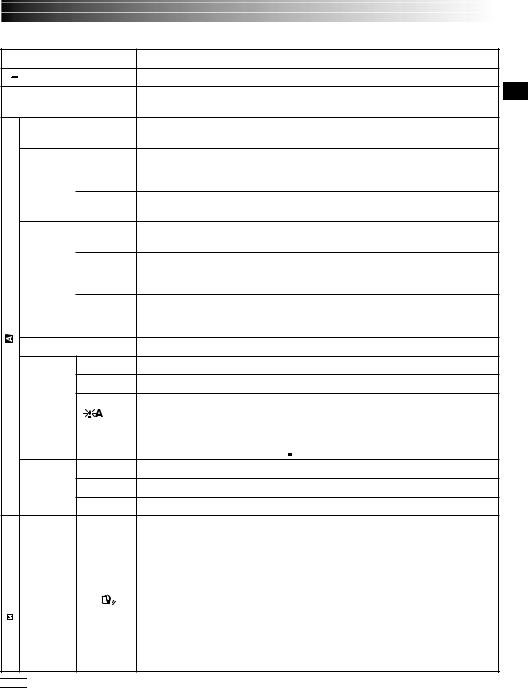
EN27
Menu Screen Explanations
 FADER/WIPE
FADER/WIPE
 PROGRAM AE
PROGRAM AE
 W.BALANCE
W.BALANCE
REC MODE
SOUND |
12 BIT |
|
MODE |
|
|
|
|
|
|
16 BIT |
|
ZOOM |
10X |
|
|
|
|
|
40X |
|
CAMERA |
|
|
300X |
||
|
||
|
|
|
SNAP MODE |
||
GAIN UP |
OFF |
|
|
|
|
|
AGC |
|
|
AUTO |
|
|
CAMERA |
VIDEO |
|
|
MODE |
DUAL |
|
|
|
|
|
|
|
|
PS-VIDEO |
|
DIS |
OFF |
|
MANUAL |
|
|
|
|
ON |
||
|
|
|
|
|
|
|
|
|
|
|
|
Refer to “Fade/Wipe Effects” ( pg. 32, 33).
Refer to “Programme AE With Special Effects” ( pg. 34, 35).
Refer to “White Balance Adjustment” and “Manual White Balance Operation” ( pg. 37).
Allows you to set the video recording mode (SP or LP) depending on your pre-ference ( pg. 13).
Enables video recording of stereo sound on four separate channels, and is recommended for use when performing audio dubbing. (Equivalent to the 32 kHz mode of previous models)
Enables video recording of stereo sound on two separate channels. (Equivalent to the 48 kHz mode of previous models)
When set to “10X” while using digital zoom, the zoom magnification will reset to 10X since digital zoom will be disengaged.
Allows you to use the Digital Zoom. By digitally processing and magnifying images, zooming is possible from 10X (the optical zoom limit), to a maximum of 40X digital magnification.
Allows you to use the Digital Zoom. By digitally processing and magnifying images, zooming is possible from 10X (the optical zoom limit), to a maximum of 300X digital magnification.
Refer to “Snapshot (For Video Recording)” ( pg. 18).
Allows you to shoot dark scenes with no picture brightness adjustment.
The overall appearance may be grainy, but the image is bright.
The shutter speed is automatically adjusted (1/25 — 1/200 sec.). Shooting a subject in low or poor lighting at 1/25 sec. shutter speed provides a brighter image than in the AGC mode, but the subject’s movements are not smooth or natural. The overall appearance may be grainy. While the shutter speed is being automatically adjusted, “ ” is displayed.
” is displayed.
Enables regular video shooting.
Enables “Dual Shooting” ( pg. 24).
Enables “Progressive Mode Recording” ( pg. 22).
To compensate for unstable images caused by camera-shake, particularly at high magnification.
NOTES:
●Accurate stabilisation may not be possible if hand shake is excessive, or under the following conditions:
•When shooting subjects with vertical or horizontal stripes.
•When shooting dark or dim subjects.
•When shooting subjects with excessive backlighting.
•When shooting scenes with movement in various directions.
•When shooting scenes with low-contrast backgrounds.
●Switch off this mode when recording with the camcorder on a tripod.
●The “
 ” indicator blinks or goes out if the Stabiliser cannot be used.
” indicator blinks or goes out if the Stabiliser cannot be used.

 : Factory-preset
: Factory-preset
NOTES:
●The “ CAMERA” settings are effective when the Power Switch is set to both “
CAMERA” settings are effective when the Power Switch is set to both “ ” and “
” and “ ”.
”.
●The “  MANUAL” settings are effective only when the Power Switch is set to “
MANUAL” settings are effective only when the Power Switch is set to “ ”.
”.
CONTINUED ON NEXT PAGE

28 EN RECORDING Advanced Features For Video And D.S.C. (cont.)
Menu Screen Explanations (cont.)
MANUAL
SELF-TIMER
5S OFF
5S
ANIM.
TELE OFF
MACRO
ON
WIDE OFF
MODE
CINEMA
SQUEEZE
PS-WIDE
SW
WIND OFF
CUT
ON
Refer to “Self-Timer” ( pg. 30).
Refer to “5-Second Recording” ( pg. 31).
Allows you to record a few frames only. By using an inanimate object and changing its position between shots, you can record the subject as though it is moving ( pg. 31).
Usually the distance to a subject where the lens is in focus depends on the zoom magnification. Unless there is a distance more than 1m to the subject, the lens is out of focus at the maximum telephoto setting. When set to “ON”, you can shoot a subject as large as possible at a distance of approx. 60 cm.
•Depending on the zoom position, the lens may go out of focus.
Records with no change in the screen ratio. For playback on a TV with a normal screen ratio.
Inserts black bands at the top and bottom of the screen. During playback on wide-screen TVs, the black bands at the top and bottom of the screen are cut and the screen ratio becomes 16:9.  appears. When using this mode, refer to your wide-screen TV’s instruction manual. During playback/recording on 4:3 TVs/LCD monitor/viewfinder, black bands are inserted at the top and bottom of the screen and the image appears like a letterboxed 16:9 movie. •“CINEMA” mode is effective only when the Shooting Mode Switch is set to
appears. When using this mode, refer to your wide-screen TV’s instruction manual. During playback/recording on 4:3 TVs/LCD monitor/viewfinder, black bands are inserted at the top and bottom of the screen and the image appears like a letterboxed 16:9 movie. •“CINEMA” mode is effective only when the Shooting Mode Switch is set to
“VIDEO” ( pg. 12) and “CAMERA MODE” is set to “VIDEO” or “PSVIDEO” in the Menu Screen ( pg. 27).
For playback on TVs with an aspect ratio of 16:9. Naturally expands the image to fit the screen without distortion.  appears. When using this mode, refer to your wide-screen TV’s instruction manual. During playback/ recording on 4:3 TVs/LCD monitor/viewfinder, the image is elongated vertically.
appears. When using this mode, refer to your wide-screen TV’s instruction manual. During playback/ recording on 4:3 TVs/LCD monitor/viewfinder, the image is elongated vertically.
•“SQUEEZE” mode is effective only when the Shooting Mode Switch is set to “VIDEO” ( pg. 12) and “CAMERA MODE” is set to “VIDEO” or “PSVIDEO” in the Menu Screen ( pg. 27).
“ |
SW |
” appears. The zoom range is extended beyond the maximum optical |
|
|
zoom wide angle range. This mode’s wide angle setting is equivalent to using a 0.7X wide conversion lens. Zooming is possible from 0.7X to 10X. This mode is suitable for shooting in a small room.
•“PS-WIDE” mode is effective only when the Shooting Mode Switch is set to “VIDEO” ( pg. 12) and “CAMERA MODE” is set to “PS-VIDEO” in the Menu Screen ( pg. 27).
Disengages the function which cuts down on noise created by wind.
Helps cut down on noise created by wind. “ ” appears. The quality of the sound will change. This is normal.
” appears. The quality of the sound will change. This is normal.

 : Factory-preset
: Factory-preset
NOTE:
The “  MANUAL” settings are effective only when the Power Switch is set to “
MANUAL” settings are effective only when the Power Switch is set to “  ”.
”.
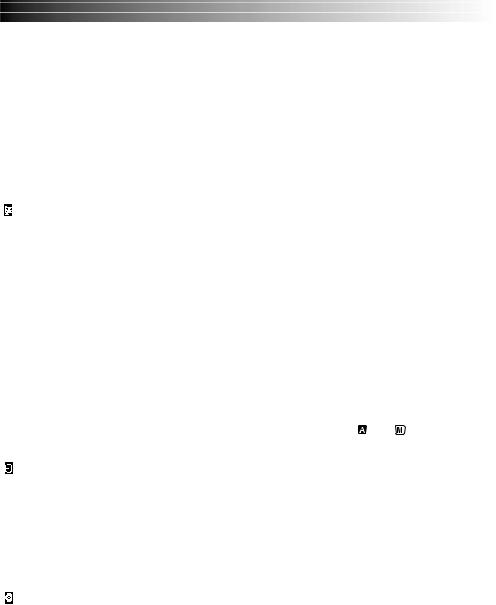
|
|
|
|
|
EN29 |
||
|
|
|
|
|
|
||
|
BEEP |
|
OFF |
Even though not heard while shooting, shutter sound is recorded on the tape. |
|
|
|
|
|
|
|
|
|
|
|
|
|
|
|
BEEP |
The beep sounds when the power is turned on or off, and at the beginning and end |
|
|
|
|
|
|
|
of recording. Also to activate the shutter sound effect ( pg. 18, 19). |
|
|
|
|
|
|
|
|
|
|
|
|
|
|
MELODY |
Instead of a beep, a melody sounds when any operation is performed. It also |
|
|
|
|
|
|
|
activates the shutter sound effect ( pg. 18, 19). |
|
|
|
TALLY |
|
OFF |
The tally lamp remains off at all times. |
|
|
|
|
|
|
|
|
|
|
|
SYSTEM |
|
|
|
ON |
The tally lamp comes on to signal the start of recording. |
|
|
DEMO |
|
OFF |
Automatic demonstration will not take place. |
|
|
||
MODE |
|
|
|
|
|||
|
ON |
Demonstrates certain functions such as Programme AE with special effects, |
|
|
|||
|
|
|
|
|
etc., and can be used to confirm how these functions operate. When “DEMO |
|
|
|
|
|
|
|
MODE” is set to “ON” and the Menu Screen is closed, demonstration starts. |
|
|
|
|
|
|
|
Performing any operation during the demonstration stops the demonstration |
|
|
|
|
|
|
|
temporarily. If no operation is performed for more than 1 minute after that, |
|
|
|
|
|
|
|
the demonstration will resume. |
|
|
|
|
|
|
|
NOTES: |
|
|
|
|
|
|
|
● If a tape is in the camcorder, the demonstration cannot be turned on. |
|
|
|
|
|
|
|
● “DEMO MODE” remains “ON” even if the camcorder power is turned off. |
|
|
|
|
|
|
|
● If “DEMO MODE” remains “ON”, some functions will not be available. |
|
|
|
|
|
|
|
After viewing demo, set to “OFF”. |
|
|
|
ON |
|
LCD |
Keeps the camcorder’s display (except the date, time and time code) from |
|
|
|
|
SCREEN |
|
|
appearing on the connected TV screen. |
|
||
|
|
|
|
|
|
|
|
|
|
|
|
LCD/TV |
Makes the camcorder’s display appear on screen when the camcorder is |
|
|
|
|
|
|
|
connected to a TV. |
|
|
|
DATE/ |
|
OFF |
The date/time does not appear. |
|
|
|
|
TIME |
|
|
|
|
|
|
DISPLAY |
|
AUTO |
Displays the date/time for approx. 5 seconds in the following cases: |
|
|
||
|
|
|
|
||||
|
|
|
|
•When the Power Switch is set from “OFF” to “ ” or “ ”. |
|
|
|
|
|
|
|
|
|
||
|
|
|
|
|
•When video playback starts. The camcorder displays the date/time when |
|
|
|
|
|
|
|
scenes are recorded. |
|
|
|
|
|
|
|
•When the date is changed during video playback. |
|
|
|
|
|
|
ON |
The date/time is always displayed. |
|
|
|
|
|
|
|
|
|
|
|
TIME |
|
OFF |
Time code is not displayed. |
|
|
|
|
CODE |
|
ON |
Time code is displayed on the camcorder and on the connected TV. Frame |
|
|
|
|
|
|
|
|
|||
|
|
|
|
|
numbers are not displayed during recording. |
|
|
|
|
|
|
|
|
||
|
CLOCK ADJ. |
Allows you to set the current date and time ( pg. 9). |
|
|
|||
|
|
|
|
|
|
|
|
DSC |
QUALITY |
|
|
Refer to “Picture Mode Setting” ( pg. 14). |
|
|
|
|
|
|
|
||||
|
SIZE |
|
|
|
|
|
|
|
UXGA |
|
|
|
|
|
|
|
|
|
|
|
|
|
|
|
|
: Factory-preset |
|
|
|
||
|
|
|
|
|
|||
NOTES:
● “ SYSTEM” and “
SYSTEM” and “ DISPLAY” functions which are set when the Power Switch is set to “
DISPLAY” functions which are set when the Power Switch is set to “ ” are also applied when the Power Switch is set to “
” are also applied when the Power Switch is set to “ ” ( pg. 39). “CLOCK ADJ.” only appears when the Power Switch is set to “
” ( pg. 39). “CLOCK ADJ.” only appears when the Power Switch is set to “ ”.
”.
●The “  DISPLAY” settings are effective even when the Power Switch is set to “
DISPLAY” settings are effective even when the Power Switch is set to “ ”.
”.
●The “ON SCREEN” setting can also be changed by pressing the DISPLAY Button on the remote control
(provided) ( pg. 53, 56, 66).
